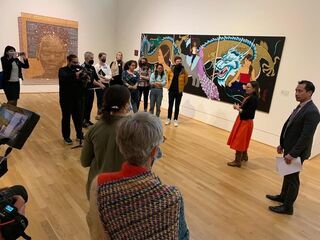Creativity
Art Builds Understanding
New science shows the connection between art creation and appreciation.
Posted November 3, 2022 Reviewed by Vanessa Lancaster
Key points
- Philosophical theory of aesthetic cognitivism proposes that art facilitates understanding ourselves, the world, and moral and spiritual concepts.
- Art reception and art creation are connected in a mirror-reversed fashion.
- Research shows a correspondence between artists and viewers; viewers tend to experience the emotions artists aim to portray in their works.
- Appreciating art can help develop one's creative thinking.
This post was co-authored by Dr. Pablo P. L. Tinio, Professor and Chair of the Department of Educational Foundations at Montclair State University.

At the just completed Designing for Empathy Summit, social scientists and museum leaders gathered to discuss how museums can build empathy and contribute to developing understanding and meaning-making.
Despite the long history of scholarship on experiences of art, researchers have yet to capture and understand the most meaningful aspects of such experiences, including the thoughts and insights we gain when we visit a museum, the sense of encounter after seeing a meaningful work of art, or the changed thinking after experiences with art. These powerful encounters can be inspiring, uplifting, and contribute to well-being and flourishing.
The theory of aesthetic cognitivism describes the value of art through its role in facilitating a better understanding of ourselves, the human condition, and moral and spiritual concepts. The question is how that happens–what are the attributes of meaningful experiences of art?
According to the mirror model of art developed by Pablo P. L. Tinio, aesthetic reception corresponds to artistic creation in a mirror-reversed fashion. Artists aim to express ideas and messages about the human condition or the world at large. To do so, they explore key ideas and continually expand, adapt, and fine-tune them as they develop the work, resulting in the build-up of layers of materials—from initial studies and sketches to the final, refined piece.
A viewer’s initial interaction with an artwork starts where the artist has left off. Their interaction first involves the processing surface features, such as color, texture, and the finishing touches applied by the artist during the final stages of the creative process. After spending more time with the work, the viewer begins to gain insight and access the ideas of the artist.
Mirroring of artists and viewers happens in relation to both the emotional and cognitive aspects of art. Tinio and Andreas Gartus compared the emotional characteristics of art and viewers’ emotional experiences of the art. They recruited visitors to the Whitney Museum of American Art who either went to view exhibitions of the permanent collection or a temporary special exhibit. These two exhibits were selected because of their distinctly different emotional tones. While the permanent collection could be best described as formal and serious, the special exhibit included interactive and playful works by Cory Arcangel.
Visitors were asked to indicate what emotions the art evoked. They were first asked about the overall feelings evoked by each exhibition as a whole. As predicted by the mirror model of art, there was a correspondence between visitors’ emotions and the emotional characteristics of the exhibits–the permanent collection exhibit evoked interest and engagement, and the special exhibit evoked amusement and laughter.
Visitors were also asked about feelings evoked by individual works of art. Again, there was a correspondence between visitors’ feelings and the emotional attributes of art. For example, visitors described feeling longing, nostalgia, and being unburdened when viewing Georgia O’Keefe’s Ladder to the Moon, which shows a wooden household ladder suspended in the turquoise sky, with dark mountains in the background.
The artist described the feeling of the painting using similar terms as the visitors who viewed it 60 years later. A very different emotional content was portrayed in A. A. Bronson’s painting Felix Partz, which depicts the artist’s friend and colleague three hours after he died of AIDS. Viewers identified sadness, despair, and compassion as evoked by the painting.
The mirror model of art also describes the correspondence of understandings and thinking processes between art creation and appreciation. Viewers often describe gaining an understanding of themselves or the world and reaching new insights and perspectives after engaging with art. With his Migration series, Jacob Lawrence aimed to tell a neglected story of more than one million African Americans from the rural South moving to the industrial North. And the viewers gain a new perspective on the story, coming to see the great migration as an integral part of American history.
Finally, art making and art viewing are connected by creative thinking. Research in my lab at Yale University shows that an educational program that uses art appreciation activities, such as sustained observation, reflection, and perspective shifting, builds creative thinking skills. For example, in one activity, people are asked to view a work of art from different perspectives–from close up or far away, by imagining being a child or mentally entering the piece and walking around it. Such activities directly put research findings to use.
Studies showed that the more time visitors spent engaging with art and the more they reflected on it, the greater the correspondence with the artists’ intentions and ideas. Indeed, participants recounted that after the course, they were better at “extrapolating art to personal life,” described realizing that “the association of real problems with possible solutions shows the utility [art] has,” and appreciated being able “to improve personal abilities you generally don’t work on.”
When we tested the effects of the art appreciation program, the results showed that participants were more original in their thinking when compared to those who did not take part in the program. The way we tested creative thinking was not related to art, making the test a strict one because people had to apply skills from one context (engaging with art in a museum) to another (questions about hypothetical situations).
For example, we asked people to come up with creative ideas for how to use common everyday objects (e.g., button) and to restate everyday problems in different ways (e.g., “You are working on a project with a group, and one person is not doing any of the work” restated multiple times starting with, “How do I…”). Importantly, when we tested people several months later, creative thinking skills were maintained.
Correspondence in feeling and thinking suggests a transfer–between creator and viewer–of ideas, concepts, and emotions contained in the works of art. Art has the potential to communicate across space and time and create connections and insights that otherwise would not happen. What it takes for this to happen is active engagement with art in contexts that facilitate this engagement, especially museums.
References
Baumberger, C. (2013). Art and understanding: In defense of aesthetic cognitivism. In M. Greenlee et al. (Eds.), Bilder sehen: Perspektiven der Bildwissenschaft (pp. Pages 41–67). Regensburg: Schnell & Steiner.
Ebert, M., Hoffmann, J. D., Ivcevic, Z., Phan, C., & Brackett, M. A. (2015). Creativity, emotion, and art: Development and initial evaluation of a workshop for professional adults. International Journal of Creativity and Problem Solving, 25, 47-59.
Graham, G. (2005). Philosophy of the Arts: An Introduction to Aesthetics. New York: Routledge.
Hoffmann, J. D., Ivcevic, Z., & Maliakkal, N. T. (2018). Creative thinking strategies for life: A course for professional adults using art. Journal of Creative Behavior. Advanced online publication. doi: 10.1002/jocb.366
Tinio, P. P. L. (2013). From artistic creation to aesthetic reception: The mirror model of art. Psychology of Aesthetics, Creativity, and the Arts, 7(3), 265–275. https://doi.org/10.1037/a0030872
Tinio, P. P. L., & Gartus, A. (2018). Characterizing the emotional response to art beyond pleasure: Correspondence between the emotional characteristics of artworks and viewers’ emotional responses. Progress in Brain Research, 237, 319-342. doi:10.1016/bs.pbr.2018.03.005.




